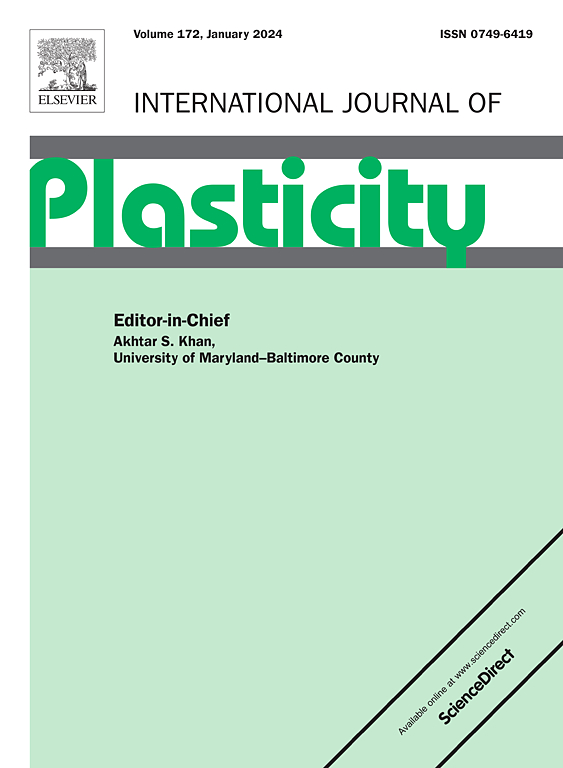由多晶金属微观结构演变介导的新型畸变各向异性硬化模型:理论与验证
IF 9.4
1区 材料科学
Q1 ENGINEERING, MECHANICAL
引用次数: 0
摘要
在这项研究中,我们引入了一种新的各向异性硬化模型,旨在捕捉复杂加载路径下的宏观力学响应,同时考虑晶体结构的细观演变。该模型基于均匀变形各向异性硬化框架,将各滑移体系的塑性剪切应变作为内部变量。利用塑性功等效原理,根据速率无关晶体塑性理论的演化规律,确定了滑移体系内的塑性剪切速率。该模型评估了包辛格效应和瞬态硬化在晶粒水平上的影响,并将其整合到宏观屈服函数中来描述现象性硬化响应。该模型已经通过实验和计算多晶CP方法进行了广泛的验证,证明了它在捕获FCC和BCC材料的晶体结构演变和复杂的各向异性硬化行为方面的有效性。提出的硬化模型标志着材料行为建模的重大进步,有效地弥合了微观结构机制和宏观力学行为之间的差距,更切合实际。本文章由计算机程序翻译,如有差异,请以英文原文为准。
Novel distortional anisotropic hardening model mediated by microstructure evolutions in polycrystalline metals: Theory and validation
In this study, we introduce a novel anisotropic hardening model designed to capture the macroscopic mechanical responses under complex loading paths while considering the mesoscopic evolutions of crystallographic structures. Based on the framework of homogeneous distortional anisotropic hardening, this model treats the plastic shear strain of each slip system as an internal variable. Utilizing the plastic work equivalence principle, the plastic shear rate within the slip system is determined, aligning with the evolution laws of rate-independent crystal plasticity (CP) theory. The model evaluates the Bauschinger effect and transient hardening at grain level and integrates it into the macroscopic yield function to describe phenomenological hardening responses. The model has been extensively validated against experimental and computational polycrystalline CP approaches, demonstrating its efficacy in capturing both the evolution of crystal textures and complex anisotropic hardening behaviors for both FCC and BCC materials. This proposed hardening model marks a significant advancement in material behavior modeling, effectively bridging the gap between microstructural mechanisms and macroscopic mechanical behavior in better practical way.
求助全文
通过发布文献求助,成功后即可免费获取论文全文。
去求助
来源期刊

International Journal of Plasticity
工程技术-材料科学:综合
CiteScore
15.30
自引率
26.50%
发文量
256
审稿时长
46 days
期刊介绍:
International Journal of Plasticity aims to present original research encompassing all facets of plastic deformation, damage, and fracture behavior in both isotropic and anisotropic solids. This includes exploring the thermodynamics of plasticity and fracture, continuum theory, and macroscopic as well as microscopic phenomena.
Topics of interest span the plastic behavior of single crystals and polycrystalline metals, ceramics, rocks, soils, composites, nanocrystalline and microelectronics materials, shape memory alloys, ferroelectric ceramics, thin films, and polymers. Additionally, the journal covers plasticity aspects of failure and fracture mechanics. Contributions involving significant experimental, numerical, or theoretical advancements that enhance the understanding of the plastic behavior of solids are particularly valued. Papers addressing the modeling of finite nonlinear elastic deformation, bearing similarities to the modeling of plastic deformation, are also welcomed.
 求助内容:
求助内容: 应助结果提醒方式:
应助结果提醒方式:


